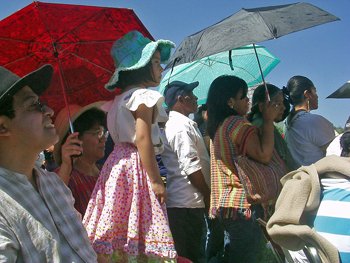


The Popular Guelaguetza versus the Government Guelaguetza
"40,000 attended the Popular Guelaguetza which was organized and funded by Section 22 and the APPO..."
By Nancy Davies
Commentary from Oaxaca
July 21, 2009
The day of the rival Guelaguetzas in Oaxaca, Monday July 21, dawned warm and became hot. Only bus drivers, taxi drivers and police appeared to be working; the man who doesn’t sell drinking water on Sunday didn’t show up on Monday either. The street traffic flowed toward one festival or the other, depending on one’s politics, affiliations or obligations.
 D.R. 2009 – Nancy Davies |
At the Popular Guelaguetza I passed the food stalls, the artisan stalls, the requests for financial assistance for Juan Manuel Martinez Moreno’s legal fees (he’s the one who didn’t shoot Brad Will), to enter at 10:30. Beyond the security lines (teachers and APPO, no police anywhere) the athletic field of the Instituto Tecnológico de Oaxaca stadium rippled with national tourists, foreign tourists and a majority of Oaxacan families filling the stands. Others waded through the crowds carrying folding chairs to set up in front of the bleachers on the field. So we lugged chairs and sat, not a minute too soon; the empty grass vanished. Many people carried umbrellas, per Oaxaca habit, as a sunshade or water shield in case it rains— these dual purpose umbrellas unfurled like colored mushrooms all across the area.
 D.R. 2009 – Alan Freeburn |
Santiago Chepi spoke flanked by the dancers of the first delegation, from Tlocolula. The dancers are not all trim under-forty professionals, they include a good salting of older, sturdy participants one can imagine dancing all their lives. On the stage behind him a huge banner, “Welcome to the Teachers and Popular Guelaguetza”, flapped in the breeze. Santiago Chepi’s speech was supplemented by the Viva!’s of the crowd. The dances surprised me – for example, the Chalcotongo delegation carried a banner on a staff, and unless I’m completely bonkers, it showed a picture of Che Guevarra. (By then I was busily snapping photos with a dead battery.) Also among the dances, several had never been seen before at a statewide event like this; for example one from the Noxichtlan region in which men with “white” Spaniard face masks snapped whips while the dancers circled a pole twining ribbons. In another dance, the men wore goat face masks with the hair hanging down.
For some reason, the governor never invited these towns to perform for him and his cronies. On Monday morning Radio Hit (affiliated with Noticias) mentioned that the delegation from La Costa (the western Pacific coast of Oaxaca, where African-Mexicans have lived for centuries) lodged a complaint for having never been invited to the government Guelaguetza.
 D.R. 2009 – Nancy Davies |
In a taxi on the way home we passed the auditorium on Fortin Hill. The roadway was clogged with buses hired to bring people into the city from their towns, and dozens of police vehicles. I asked the taxi driver why there was so big a police presence, and he replied, “to prevent the teachers from attacking the Guelaguetza”. I responded, “Well, how could they attack here while they are all at the Guelaguetza Popular at the Tecnologico?” “But they might send thugs,” he insisted.
Governor Ulises Ruiz Ortiz, according to news reporters, insisted that the Guelaguetza “is from the people of Oaxaca and not from the state government”. Also he added that attendance had surpassed expectations because hotel occupation has reached 85%, a figure which is routinely discounted by non-public relations people. One wonders how he knows where those tourists went, but among his own special guests were the governor-elect of San Luis Potosí, Fernando Toranzo, and seventeen PRI federal deputies (representatives) from Chiapas, Guerrero, San Luis Potosí, Nuevo León, Durango, Michoacán and Veracruz.
Click here for more Narco News coverage of Mexico
- The Fund for Authentic Journalism
For more Narco News, click here.




